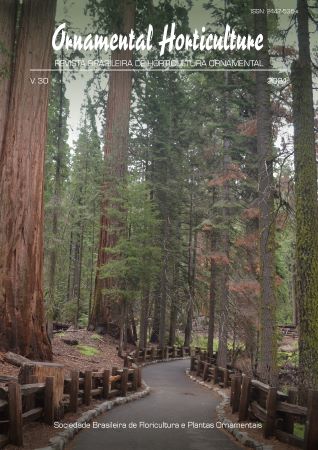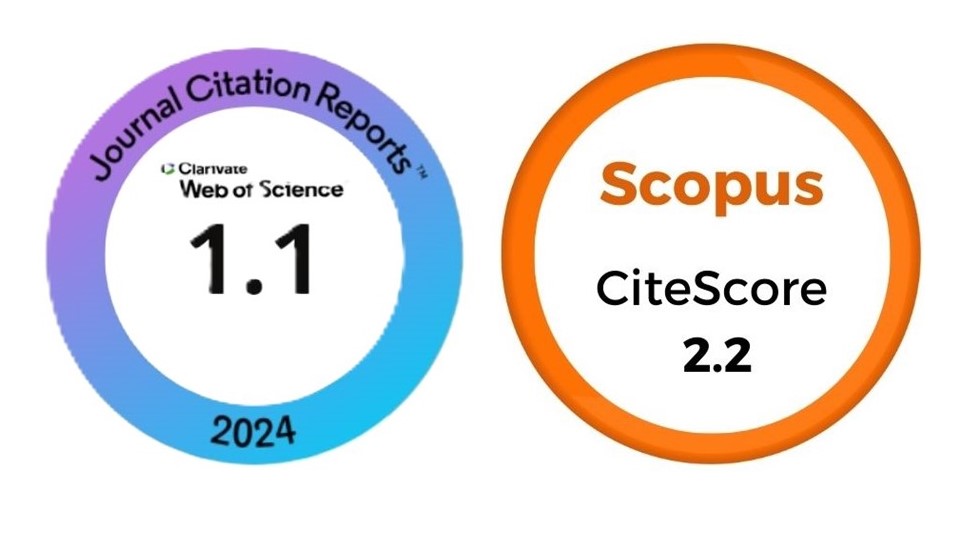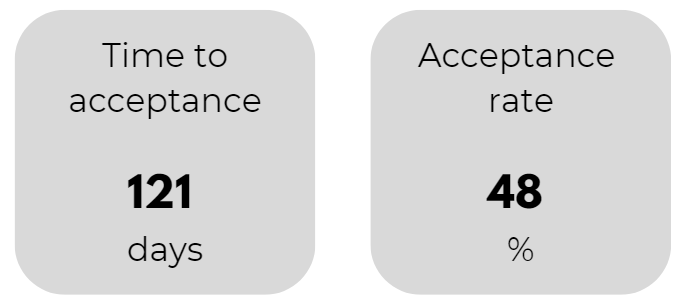Caracterização fisiológica e bioquímica de um cultivar suscetível de cravo (Dianthus caryophyllus L.) à Fusarium oxysporum f. sp. dianthi (Fod)
DOI:
https://doi.org/10.1590/2447-536X.v30.e242750Palavras-chave:
cravo, compostos fenólicos, flavonoides, fluorescência da clorofila α, resistência estomática, temperatura foliarResumo
A susceptibilidade das cravinas (Dianthus caryophyllus L.) à infecção por Fusarium oxysporum f. sp. dianthi (Fod) representa um desafio significativo para a produção agrícola, especialmente na Colômbia, país líder mundial na exportação de cravinas. Este estudo concentrou-se nas respostas fisiológicas e bioquímicas de uma cultivar de cravina altamente suscetível, ‘Solex’, à presença de Fod, visando compreender melhor os mecanismos subjacentes à suscetibilidade e aprimorar estratégias de detecção precoce de doenças em cultivos de cravina. No nível bioquímico, analisamos o teor de compostos fenólicos e flavonoides em raízes e hastes; e avaliamos parâmetros fisiológicos como conteúdo foliar de pigmentos fotossintéticos, resistência estomática, eficiência fotoquímica máxima de PSII (Fv/Fm) e temperatura foliar. Nossa pesquisa revelou uma diminuição acentuada na produção de metabólitos nas raízes de plantas de cravina inoculadas com Fod, especialmente evidente aos 4 dias pós-inoculação. Além disso, observamos um aumento precoce na temperatura foliar a partir do primeiro dia pós-inoculação, sem alterações na dinâmica de fechamento estomático ao longo do tempo. Adicionalmente, registramos uma significativa redução em Fv/Fm, conteúdo de pigmentos fotossintéticos e produção de biomassa seca em plantas inoculadas com Fod durante a fase sintomática do murchamento vascular, contrastando fortemente com os controles livres de patógenos. Esses achados destacaram a suscetibilidade intrínseca das plantas de cravina à infecção por Fod, com implicações significativas para o aprimoramento da resistência das plantas e o desenvolvimento de estratégias eficazes de manejo do murchamento vascular em cultivos desta flor.
Downloads
Referências
ARBELÁEZ-TORRES, G.; CALDERÓN, O.L.; CEVALLOS, F.; GONZÁLEZ, D. Determinación de las razas fisiológicas de Fusarium oxysporum f. sp. dianthi en clavel en la sabana de Bogotá. Agronomía Colombiana, v.10, n.1, p.19-27, 1993. https://revistas.unal.edu.co/index.php/agrocol/article/view/21227
ARDILA, H.D.; MARTÍNEZ, S.T.; HIGUERA, B.L. Levels of constitutive flavonoid biosynthetic enzymes in carnation (Dianthus caryophyllus L.) cultivars with differential response to Fusarium oxysporum f. sp. dianthi. Acta Physiologiae Plantarum, v.35, n.4, p.1233-1245, 2013. https://doi.org/10.1007/s11738-012-1162-0
BADR, A.; BRÜGGEMANN, W. Comparative analysis of drought stress response of maize genotypes using chlorophyll fluorescence measurements and leaf relative water content Photosynthetica, v.58, (SI), p.638-645, 2020. https://doi.org/10.1146/annurev.arplant.59.032607.092759
CALDERÓN, R.; NAVAS-CORTÉS, J.A.; LUCENA, C.; ZARCO-TEJADA, P.J. High-resolution airborne hyperspectral and thermal imagery for early detection of Verticillium wilt of olive using fluorescence, temperature and narrow-band spectral indices. Remote Sensing of Environment, v.139, p.231-245, 2013. https://doi.org/10.1016/j.rse.2013.07.031
CHÁVEZ-ARIAS, C.C.; GÓMEZ-CARO, S.; RESTREPO-DÍAZ, H. Physiological, biochemical and chlorophyll fluorescence parameters of Physalis peruviana L. seedlings exposed to different short-term waterlogging periods and Fusarium wilt infection. Agronomy, v.9, n.5, p.213, 2019. https://doi.org/10.3390/agronomy9050213
DEVAPPA, V.; ARCHITH, TC. Wilt diseases of ornamental crops and their management. In: BHATTACHARYYA, B.N.; CHAKRABORTY, R.N.; PANDEY, D.S.; DUBEY, SC. (Eds.), Wilt Diseases of Crops and their Management. New Delhi, India: IPSDIS, 2019.
DI, X.; TAKKEN, F.L.W.; TINTOR, N. How phytohormones shape interactions between plants and the soil-borne fungus Fusarium oxysporum. Frontiers in Plant Science, v.7, p.1-9, 2016. https://doi.org/10.3389/fpls.2016.00170
DONG, X.; LING, N.; WANG, M.; SHEN, Q.; GUO, S. Fusaric acid is a crucial factor in the disturbance of leaf water imbalance in Fusarium-infected banana plants. Plant Physiology and Biochemistry, v.60, p.171-179, 2012. https://doi.org/10.1016/j.plaphy.2012.08.004
DONG, X.; XIONG, Y.; LING, N.; SHEN, Q.; GUO, S. Fusaric acid accelerates the senescence of leaf in banana when infected by Fusarium. World Journal of Microbiology and Biotechnology, v.30, n.4, p.1399-1408, 2014. https://doi.org/10.1007/s11274-013-1564-1
FRANCESCONI, S.; HARFOUCHE, A.; MAESANO, M.; BALESTRA, G.M. UAV-Based Thermal, RGB imaging and gene expression analysis allowed detection of Fusarium head blight and gave new insights into the physiological responses to the disease in durum wheat. Frontiers in Plant Science, v.12, p.1-19, 2021. https://doi.org/10.3389/fpls.2021.628575
GARCÍA-RUIZ, H.; SZUREK, B.; VAN DEN ACKERVEKEN, G. Stop helping pathogens: engineering plant susceptibility genes for durable resistance. Current Opinion in Biotechnology, v.70, p.187-195, 2021. https://doi.org/10.1016/j.copbio.2021.05.005
GÓRECKI, T.; SMAGA, Ł. fdANOVA: an R software package for analysis of variance for univariate and multivariate functional data. Computational Statistics, v.34, n.2, p.571-597, 2019. https://doi.org/10.1007/s00180-018-0842-7
GORSHKOV, V.; TSERS, I. Plant susceptible responses: the underestimated side of plant-pathogen interactions. Biological Reviews, v.97, n.1, p.45-66, 2021. https://doi.org/10.1111/brv.12789
HIGUERA, B.L.; EBRAHIM-NESBAT, F. Study of vascular root responses as defense mechanisms in carnation resistant or susceptible to Fusarium oxysporum f. sp. dianthi by transmission electron microscopy. Acta Horticulturae, v.482, p.101-108, 1999. https://doi.org/10.17660/ActaHortic.1999.482.14
LOZANO-MONTAÑA, P.A.; SARMIENTO, F.; MEJÍA-SEQUERA, L.M.; ÁLVAREZ-FLÓREZ, F.; MELGAREJO, L.M. Physiological, biochemical and transcriptional responses of Passiflora edulis Sims f. edulis under progressive drought stress. Scientia Horticulturae, v.275, 2021. https://doi.org/10.1016/j.scienta.2020.109655
KUMUDINI, B.S.; JAYAMOHAN, N.S.; PATIL, S.V.; GOVARDHANA, M. Primary plant metabolism during plant–pathogen interactions and its role in defense. In: AHMAD, P.; AHANGER, M.A.; SINGH, V.P.; TRIPATHI, D.K.; ALAM, P.; ALYEMENI, M.N. Plant Metabolites and Regulation Under Environmental Stress. New York: Academic Press, 2018. p.215-229.
MARÍN-ORTIZ, J.C.; HOYOS-CARVAJAL, L.M.; BOTERO-FERNANDEZ, V. Detection of significant wavelengths for identifying and classifying Fusarium oxysporum during the incubation period and water stress in Solanum lycopersicum plants using reflectance spectroscopy. Journal of Plant Protection Research, v.59, n.2, p.244-254, 2019. https://doi.org/10.24425/jppr.2019.129290
MARTÍNEZ-GONZÁLEZ, A.P.; COY-BARRERA, E.; ARDILA, H.D. Extraction and analysis of apoplastic phenolic metabolites in carnation roots and stems (Dianthus caryophyllus L). Revista Colombiana de Química, v.51 n.1, p.3-13, 2022. https://doi.org/https://doi.org/10.15446/rev.colomb.quim.v51n1.99258
MEENA, K.S.; RAMYABHARATHI, S.A.; JONATHAN, E.I. Interaction of Meloidogyne incognita and Fusarium oxysporum in carnation and physiological changes induced in plants due to the interaction. SAARC Journal of agriculture, v.14, n.1, p.59-69. 2016. https://doi.org/https://doi.org/10.3329/sja.v14i1.29576
POLI, A.; BERTETTI, D.; RAPETTI, S.; GULLINO, M.L.; GARIBALDI, A. Characterization and identification of Colombian isolates of Fusarium oxysporum f. sp. dianthi. Journal of Plant Pathology, v.95 n.2, p.255-263, 2013. DOI: https://doi.org/http://www.jstor.org/stable/23721516
PÉREZ-MORA, W.; MELGAREJO, L.M.; ARDILA, H.D. Effectiveness of some resistance inducers for controlling carnation vascular wilting caused by Fusarium oxysporum f. sp. dianthi. Archives of Phytopathology and Plant Protection, v.54, n.13-14, p.886-902, 2021. https://doi.org/10. 1080/03235408.2020.1868734
PÉREZ-MORA, W.H.; CASTILLEJO, M.Á.; JORRÍN NOVO, J.; MELGAREJO, L.M.; ARDILA, H.D. Thiamine-induced resistance in carnation against Fusarium oxysporum f. sp dianthi and mode of action studies based on the proteomics analysis of root tissue. Scientia Horticulturae, v.323, 2024a. https://doi.org/10.1016/j. scienta.2023.112549
PÉREZ-MORA, W.; MELGAREJO, L.M.; ARDILA, H.D. Response of susceptible carnation cultivars during thiamine application as inducer of resistance to vascular wilting caused by Fusarium oxysporum f. sp. dianthi. Ornamental Horticulture, v.30, n.e242633, p.1-7, 2024b. https://doi.org/10.1590/2447-536X.v30.e242633
RASOOL, N. Plant Hormones: role in alleviating biotic stress. London: IntechOpen, 2022.
ROMERO-RINCÓN, A.; MARTÍNEZ, S.T.; HIGUERA, B.L.; COY-BARRERA, E.; ARDILA, H.D. Flavonoid biosynthesis in Dianthus caryophyllus L. is early regulated during interaction with Fusarium oxysporum f. sp. dianthi. Phytochemistry, v.192, 2021. https://doi.org/10.1016/j.phytochem.2021.112933
SANTOS-RODRÍGUEZ, J.; COY-BARRERA, E.; ARDILA, H.D. Mycelium dispersion from Fusarium oxysporum f. sp. dianthi elicits a reduction of wilt severity and influences phenolic profiles of carnation (Dianthus caryophyllus L.) roots. Plants, v.10, n.7, p.1447, 2021. https://doi.org/10.3390/plants10071447
TORO-TOBON G.; ÁLVAREZ-FLÓREZ, F.; MARIÑO-BLANCO, H.D.; MELGAREJO, L.M. Foliar functional traits of resource island-forming nurse tree species from a semi-arid ecosystem of La Guajira, Colombia. Plants, v.11, p.1723, 2022. https://doi.org/10.3390/plants11131723
VANEGAS-CANO, L.J.; MARTINEZ-PERALTA, S.T.; COY-BARRERA, E.; ARDILA-BARRANTES, H.D. Respuestas tempranas en simplasto de tallo asociadas a la ruta del ácido salicílico en la interacción clavel (Dianthus caryophyllus, caryophyllaceae)- FOD (Fusarium oxysporum f. sp. dianthi). Acta Biológica Colombiana, v.27, n.2, p. 153-163, 2022b. https://doi.org/https://doi.org/10.15446/abc.v27n2.85778
VANEGAS-CANO, L.J.; MARTÍNEZ-PERALTA, S.T.; COY-BARRERA, E.; ARDILA-BARRANTES, H.D. Plant hormones accumulation and its relationship with symplastic peroxidases expression during carnation-Fusarium oxysporum interaction. Ornamental Horticulture, v.28, n.1, p.49-59, 2022a. https://doi.org/10.1590/2447-536X.V28I1.2412
VILLARREAL-NAVARRETE, A.; FISCHER, G.; MELGAREJO, L.M., CORREA, G.; HOYOS-CARVAJAL, L. Growth response of the cape gooseberry (Physalis peruviana L.) to waterlogging stress and Fusarium oxysporum infection. Acta Horticulturae, v.1178, p.161-168, 2017. https://doi.org/10.17660/ActaHortic.2017.1178.28
WANG, M.; LING, N.; DONG, X.; ZHU, Y.; SHEN, Q.; GUO, S. Thermographic visualization of leaf response in cucumber plants infected with the soil-borne pathogen Fusarium oxysporum f. sp. cucumerinum. Plant Physiology and Biochemistry, v.61, p.153-161, 2012. https://doi.org/10.1016/j.plaphy.2012.09.015
WANG, M.; SUN, Y.; SUN, G.; LIU, X.; ZHAI, L.; SHEN, Q.; GUO, S. Water balance altered in cucumber plants infected with Fusarium oxysporum f. sp. cucumerinum. Scientific Reports, v.5, n.1, p.7722, 2015. https://doi.org/10.1038/srep07722
WANG, Y.; WU, J.; YAN, J.; GUO, M.; XU, L.; HOU, L.; ZOU, Q. Comparative genome analysis of plant ascomycete fungal pathogens with different lifestyles reveals distinctive virulence strategies. BMC Genomics, v.23, n.1, p.1-11, 2022. https://doi.org/10.1186/s12864-021-08165-1
WILSON, S.K.; PRETORIUS, T.; NAIDOO, S. Mechanisms of systemic resistance to pathogen infection in plants and their potential application in forestry. BMC Plant Biology, v.23, n.1, p.1-13, 2023. https://doi.org/10.1186/s12870-023-04391-9
ZHU, F.; XI, DH.; YUAN, S.; XU, F.; ZHANG, D.W.; LIN, H.H. Salicylic acid and jasmonic acid are essential for systemic resistance against tobacco mosaic virus in Nicotiana benthamiana. Molecular Plant-Microbe Interactions, v.27, n.6, p.567-577, 2014. https://doi.org/10.1094/MPMI-11-13-0349-R
Downloads
Publicado
Edição
Seção
Licença
Copyright (c) 2024 Ornamental Horticulture

Este trabalho está licenciado sob uma licença Creative Commons Attribution 4.0 International License.








